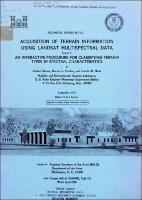Please use this identifier to cite or link to this item:
https://hdl.handle.net/11681/29020Full metadata record
| DC Field | Value | Language |
|---|---|---|
| dc.contributor.author | Grabau, Warren E. | - |
| dc.contributor.author | West, Harold W. | - |
| dc.contributor.author | Mobility and Environmental Systems Laboratory (U.S.) | - |
| dc.contributor.author | Struve, Horton | - |
| dc.date.accessioned | 2018-09-05T20:48:40Z | - |
| dc.date.available | 2018-09-05T20:48:40Z | - |
| dc.date.issued | 1977-09 | - |
| dc.identifier.govdoc | Technical Report M-77-2 Report 2 | - |
| dc.identifier.uri | http://hdl.handle.net/11681/29020 | - |
| dc.description | Technical Report | en_US |
| dc.description.abstract | Developed in the study reported herein was a semiautomated procedure for classifying Landsat radiance data in terms of preselected land-use categories. The procedure is an interim solution to the problem of mapping very large areas in terms of relatively crude categories in very short periods of time. Operation of the procedure requires an analyst to direct a computer by means of interactive instructions to search for all the 3 by 3 pixel arrays exhibiting spectral signatures that conform to a selected criterion of homogeneity. The computer then retrieves these signatures from within the array of Landsat radiance values and groups them into spectrally similar clusters. The clusters are then displayed on a color coded map overlay from which the analyst must provide the final interpretation and classification. The area selected for study is centered approximately 40 km northeast of Vicksburg, Mississippi. The area includes a representative section of loess hills, forming the eastern wall of the Mississippi floodplain, and a section of the floodplain, including an oxbow lake and a number of other floodplain features. | en_US |
| dc.description.sponsorship | Prepared tor Assistant: Secretary of the Army (R&D), Department: of the Army under Project: 4Al61 I0IA91D, Task 02, Work Unit 095 | en_US |
| dc.description.tableofcontents | PREFACE 2 CONVERSION FACTORS, METRIC (SI) TO U. S. CUSTOMARY AND U. S. CUSTOMARY TO METRIC (SI) UNITS OF MEASUREMENTS 4 PART I: INTRODUCTION 5 Background 5 Objective and Scope 6 Rationale of the Procedure 6 PART II: DEVELOPMENT OF SEMIAUTOMATED PROCEDURE 9 Theory 9 Practice 22 PART III: EVALUATION AND ADJUSTMENTS 94 Evaluation 94 Adjustments 99 PART IV: CONCLUSIONS AND RECOMMENDATIONS 104 Conclusions 104 Recommendations 104 REFERENCES 105 TABLES 1-26 PLATES 1 and 2 APPENDIX A: DESCRIPTION OF OPTRONICS FIIM READER/WRITER A1 | - |
| dc.format.extent | 143 pages / 31.09Mb | - |
| dc.format.medium | PDF/A | - |
| dc.language.iso | en_US | en_US |
| dc.publisher | U.S. Army Engineer Waterways Experiment Station | en_US |
| dc.relation.ispartofseries | Technical Report (U.S. Army Engineer Waterways Experiment Station);no.M-77-2 Report 2 | - |
| dc.rights | Approved for public release; distribution is unlimited | - |
| dc.source | The ERDC Library created this digital resource using one or more of the following: Zeta TS-0995, Zeutcehl OS 12000, HP HD Pro 42-in. map scanner, Epson flatbed | - |
| dc.subject | Landsat satellites | en_US |
| dc.subject | Remote sensing | en_US |
| dc.title | Acquisition of Terrain Information Using LANDSAT Multispectral Data. Report 2, An Interactive Procedure for Classifying Terrain Types by Spectral Characteristics | en_US |
| dc.type | Report | - |
| Appears in Collections: | Technical Report | |
Files in This Item:
| File | Description | Size | Format | |
|---|---|---|---|---|
| Technical Report M-77-2 Report 2.pdf | 31.84 MB | Adobe PDF |  View/Open |